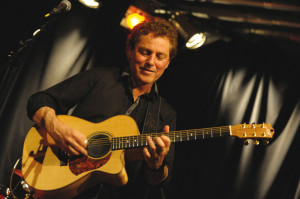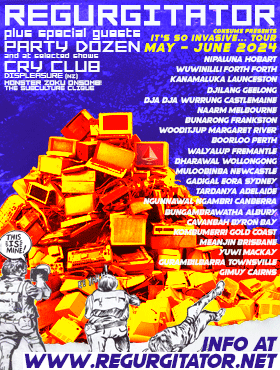MICHAEL FIXJune 2011. By Greg Phillips
 For acclaimed Australian guitarist, composer and performer Michael Fix, it seemed a case of all the moons aligning in producing his brand new album Two Timing. Good fortune led to the coming together of 13 extraordinary guitarists to record a set of duet guitar pieces for the project. The result not only showcases Fix’s amazing fingerpickin’ skills, but also parades an amazing array of some of the finest and most tasteful players you’ll find anywhere, including Tommy Emmanuel, Bruce Mathiske, Louie Shelton, Stephen Bennett, Nick Charles, and many others. AM’s Greg Phillips spoke to Michael in the lead up to the album’s release.
For acclaimed Australian guitarist, composer and performer Michael Fix, it seemed a case of all the moons aligning in producing his brand new album Two Timing. Good fortune led to the coming together of 13 extraordinary guitarists to record a set of duet guitar pieces for the project. The result not only showcases Fix’s amazing fingerpickin’ skills, but also parades an amazing array of some of the finest and most tasteful players you’ll find anywhere, including Tommy Emmanuel, Bruce Mathiske, Louie Shelton, Stephen Bennett, Nick Charles, and many others. AM’s Greg Phillips spoke to Michael in the lead up to the album’s release.
Over what period of time was it created? I imagine it would have been a difficult thing to do, getting all of these people together?
I started the concept about nine months ago. A lot of the different people that I had been working with over the past few years; including singers, singer-songwriters, musicians that play instruments other than guitar; it just felt like a cool thing to do, to reflect all of the different parts of my life. As well as performing, I am also producing and composing music. It brings me into contact with a lot of different people. I had a tour to Europe, which was in October last year, and there were some really nice coincidences that lead to some additional tracks going on the album. There were just nice coincidences all of the time.
How did you record the guitars?
A lot of the tracks were recorded here in my studio. I tended to stick to a fairly standard scenario. In other studios, I didn’t get too involved. I let the studio engineers make those decisions, but I was never disappointed. I generally use two microphones on an acoustic guitar. One pointing at about the 15th fret, where the neck meets the body, and the other pointing toward the bridge and that’s about it.
Listening to the album, I was thinking, if you weren’t familiar with the players, how would you know who was playing what? I noticed in liner notes that you are always in the left channel of all tracks. Whose idea was it to do that?
It was mine. I was thinking the same way that you just expressed. I think guitar players particularly would be interested to know who is sitting where. It also reinforces the idea that there are two people represented by what you are hearing out of each speaker.
Tommy Emmanuel does two tracks with you on the album. He has been so great as a mentor to so many guitarists, and you have continued that legacy doing the same thing, giving young players a start. I guess the proof is in the pudding with that philosophy.
Music is something that is meant to be shared. I could not imagine anyone that loves music who wouldn’t want to share what they know with people who are interested to learn. In my younger years when I first hooked up with Tommy, I was a kid from the country moving up to Sydney and there was so much to learn. He was just so generous with his time and I have never forgotten that. Not that I wouldn’t do it naturally anyway, but I see it almost as my duty to pass on as much as I can.
A couple of the young players on the album, Sam Shepherd and Jason McGregor. Obviously they have great chops, but looking back at yourself at their age, what do you know now about guitar playing that you didn’t know back then at their age?
I’d say the biggest change is using the guitar and technique and chops to create emotions and play with taste and reflect my personality. I think it the most difficult thing when you are young, is that you are still finding your personality and still finding your sound. When you are young you tend to mimic a lot of players … I certainly did. It wasn’t until I hit my mid thirties, approaching forties that I began to feel a sense of not needing to copy people. I started to develop my own sound and style and was comfortable with following that path. That’s a really difficult thing to explain to someone just starting up, be it a guitar player or singer. Eventually you have to find your own path.
Tell me about triggering which Andrew Toner did on the final track ‘Danny Boy’, and how that worked.
Andrew uses a Mini Maton guitar which has a MIDI pickup in it and he has that going into a Roland MIDI guitar set up on the floor, I think it’s a GR 20. He’ll play the chord on the guitar, with his foot he will hold down the pedal and that triggers a string sound with a slow attack on it. While he is holding it down with his foot, he is able to play over the top of it with the straight guitar sound. So he can create these textures and layers. It’s really quite beautiful the way he uses it.
Tell me about your signature model Maton guitar. How did it come about and what were the main features you needed included?
The concept came up in 2004. It was raised by Alan Samin, who is the Maton distributor in Italy. He had been taking guitar players over to Italy for a number of years. I think Tommy Emmanuel might have been one of the first people Alan took over there to basically introduce the Maton name to Italians. So Alan proposed that in 2004, which was my first trip to Europe. I had been playing a standard Maton 808 and an 808 cutaway and when they asked me what I wanted in the guitar, I was actually quite happy with what I had. I was taken aback at first because I didn’t really want to change anything, but since they asked, I guessed I had to come up with something. What I wanted in the end was the rounded cutaway. I had the pointy cutaway on the model prior. I asked for an ebony fingerboard and bridge, which is not really standard for Maton. Appearance wise I asked for the body to be a very light blonde colour so that the contrast between the ebony and the body would be strong and look distinctive, which it does. It’s very elegant, but of course with ageing, the body darkens and it doesn’t look so different anymore.
You also have a deal with AER amplification, I imagine you would play through the desk most of the time. In what situation would you use AER products?
I have a couple of amps, one is an Alpha, the other one a Compact 60, but mostly I travel with the Alpha because it’s smaller and lighter. I do try to use that wherever possible because it acts as my DI into the PA. It also gives me a really reliable monitor sound on stage. Sometimes it is not necessary if I am in a really big theatre with a lovely sound system and perfect foldback, then the amp isn’t being used very much. There have been many occasions though, especially traveling around Australia at various festivals etc, where you have minimal set up time. You run on stage, plug in, strum a couple of chords and off you go. Often in those situations, the monitors are not tuned for an acoustic guitar. They’ll be tuned by a rock and roll roadie who puts the smiley curve on the EQ and you have this really brittle top end, so If I have my own amp there, I just send that line out and they turn the monitors off. I have my own monitor with the amp and job done.
Two Timing is out now.Michael will tour Victoria in August before leaving for Europe. He has also just completed a six track EP with Nadia Sunde and Paul Robert Burton www.michaelfix.com.


